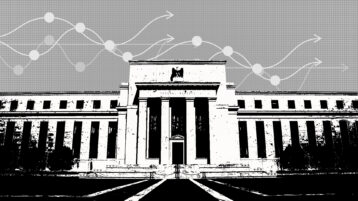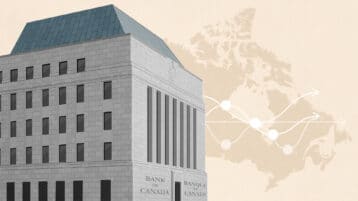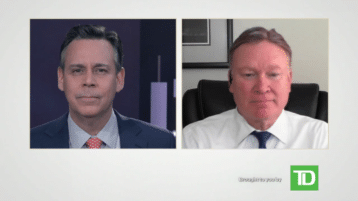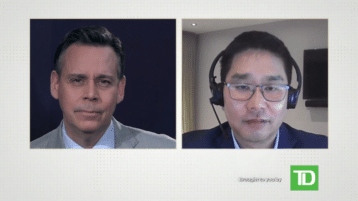Aggressive rate hikes by the U.S. Federal Reserve have been felt across all asset classes, including alternative investments. Jeff Tripp, Head of Alternative Investments at TD Asset Management, speaks with Kim Parlee about the impact and potential opportunities in a high-rate environment.
Print Transcript
[MUSIC PLAYING]
* The US Federal Reserve's efforts to fight inflation may be showing signs of paying off. The latest CPI reading for April indicated inflation had moderated a little more than expected. Aggressive rate hikes by the Fed has been felt across all asset classes, including alternative investments such as real estate. So what is the outlook going forward for that space? For more, we're joined by Jeff Tripp. He's head of Alternative Investments at TD Asset Management. Nice to have you here in person.
* Great to be here.
* I know you talk to people over COVID. And it's always, you know, over the Webex or over the screens. I know the last time we talked, we had been seeing rates start to move up. Rates have moved up an awful lot since the last time I talked to you, which I think was probably about six months ago. Where are we now in terms of the impact that's had on the private space, the alternative space?
* Yeah, I mean, rates-- rates moving up to get inflation under control. The resulting economic slowdown, I think it's something that we were able to foresee. But, like, all of these things impact the public markets, equities, fixed income has also impacted real assets. So there are elements of real assets that can help you hedge inflation.
But there's no question that there's headwinds associated with higher interest rates. It impacts valuations as an example. And you see that across all the asset classes. Now, there is variation by market and the types of assets, which we can certainly dig into. But certainly, it's a headwind.
* It's interesting too, and we will dig into it because it's fascinating. But the one thing that I had heard-- and please let me know if this is true-- is that when rates move up-- well, rates change up or down? It gets reflected in the public markets much more quickly where in private spaces, that price discovery takes longer to show up. Let me just explain a bit just for people because most people watching are much more familiar with public markets.
* Yeah, yeah, and the public-- public markets-- excuse me-- do react very differently and quickly. I think what's important to point out is you can have private investments in alternatives, or you can have the public markets, like REITs. So that would be something that you can see trade on the various exchanges. In the public market-- so public, or excuse me, the private alternatives, the valuations are done a little less frequently.
And what evaluators rely on is really transactions. So they want to see assets trade over time. And they're able to use those as data points when they're figuring out-- figuring out valuations. So when we saw the rapid increase in interest rates, inflation heading into a macro slowdown, the markets really did pull back. So there wasn't a lot of transaction volume. So the seeking of those data points to really roll into valuations--
* There was less.
* --was a little bit different or difficult, and it took some time. So we're still starting to see that play out. It has happened differently in different parts of the world. So Asia has kind of gone through that a little bit earlier. Europe and UK, we're certainly seeing stress around valuations in the US. And some of that is transpiring here in Canada. So they're all kind of different.
* Let's zero in, in one aspect. And again, and you did talk geography. I mean, sectors, I mean, it's everywhere. But I wouldn't mind talking about real estate, especially commercial real estate because that's what people seem to be talking about right now, trying to understand, still a challenging space?
* Yeah, and we-- we're mindful of a couple of things when we think about real estate, alternatives in general, but real estate. So a long-term view. So these assets are multi-generational assets. You hold them for a long period of time. So you do have to fight the tendency to focus on the short term and think long term, number one.
I think number two, the stress that we're seeing in commercial office real estate shouldn't necessarily be applied to all of the real estate asset classes. So what I mean is residential and industrial are still performing quite well. But we are seeing pronounced stress in office. So that really does highlight the importance of diversification when you're investing in real estate.
* Yeah, and do you see that continuing, the stress on the office space in the next little while?
* Yeah, we do. And the US, you can kind of delineate between the US and Canada. We are seeing more stress in some of the larger gateway markets in the United States. So, like, LA, Manhattan, San Francisco, the vacancy rates are quite escalated. Toronto, Vancouver in the Canadian context, similar types of stress. But the vacancy rates aren't quite as high.
I think the return to office and what the future of office is, is still a story to be written. The hybrid work environment is, means different things in different markets. Again, looking at Asia. So Singapore, Tokyo as examples. People are very much back to what looks like a pre-COVID work model. Europe, UK, maybe a little bit in the middle. US or North America, US and Canada, a very much still that hybrid model.
Supply of new office weighs into it. At the end of the day, we think that the well-located high-quality office that enables employers to attract and retain talent is easy to get to. So on transit, it's just a nice work environment that will ultimately perform better over the long term than some of the stuff that's a little more challenged.
* That fascinating to understand how that plays out around the world. And I'm sure a recession meeting up with RTO is going to have its own dynamic, as well, as we move ahead the next little while. What about private credit? I mean, when you look at mortgages, that type of market with rates where they are right now?
* Yeah, there's been some news and stories in the media around some stress in certain areas of the private credit market. When we think about it in the context of how we approach alts or real assets, we think about quality. We think about portfolio construction and diversification. So we are quite positive on the high-quality, investment grade, fixed-term private credit space. And in the mortgage space, that diversification between call it construction debt. So some floating rate mortgages versus term debt.
The floating rate debt enables you to adjust very quickly in an increasing interest rate environment, which we've seen on the borrower side. Obviously, that presents a challenge. But as a lender, you do get that adjustment fairly quickly to the market. And then on the fixed rate debt, no question interest rates are up. And I think the market is looking for some stability on rates.
If you're a borrower, you want to see that stability in interest rates. You want to understand where things are going from a macro perspective. A little less transaction volume. In some cases, materially less transaction volume on account of the higher rates and the macro conditions. So it's a little bit of a mixed bag. But in that high quality space, both private credit and mortgages, we're quite optimistic.
* Hmm. I wish I had you for another two hours. But I've only got one more minute I need to ask you. Infrastructure. When you think about energy and transportation and I guess infrastructure and other international markets, what's interesting?
* Yeah, so where real estate may be a little more challenged, infrastructure has been quite resilient. And I think there's a number of reasons for that. A couple of the larger ones would be just that the amount of capital looking to be deployed into infrastructure and some of those longer-term themes, like the transition from conventional or traditional energy generation to renewable so that those are global themes that we're seeing unfolding.
Aging infrastructure in the Canadian context. So there's always a need for capital. P3, so public, private partnerships are a great way to get large projects delivered. So hospitals, that type of thing. So there's always a need for infrastructure. And we're seeing the evolution of demand from investors to be wanting to be more exposed to the infrastructure space.
* I would think-- and, sorry, I've only got 30 seconds. But with the infrastructure space, and there's so much demand, I would say over time. But I'm sure there's lots of dollars competing for that at the same time. I mean, what's the valuation like in that-- I know it depends everywhere.
* Yeah, it does depend. It's been fairly resilient. So where you see increased or higher interest rates, that does impact your valuation exactly. It's a little bit of a headwind. But infrastructure can act as a partial inflation hedge. So you're able to pass on some higher costs, whether it's energy, production--
* Rent.
* --rent, that type of thing. So it's a little bit of an offset. It's been fairly stable from a valuation perspective. But you're right. It depends on geography, depends on asset class.
[MUSIC PLAYING]
* The US Federal Reserve's efforts to fight inflation may be showing signs of paying off. The latest CPI reading for April indicated inflation had moderated a little more than expected. Aggressive rate hikes by the Fed has been felt across all asset classes, including alternative investments such as real estate. So what is the outlook going forward for that space? For more, we're joined by Jeff Tripp. He's head of Alternative Investments at TD Asset Management. Nice to have you here in person.
* Great to be here.
* I know you talk to people over COVID. And it's always, you know, over the Webex or over the screens. I know the last time we talked, we had been seeing rates start to move up. Rates have moved up an awful lot since the last time I talked to you, which I think was probably about six months ago. Where are we now in terms of the impact that's had on the private space, the alternative space?
* Yeah, I mean, rates-- rates moving up to get inflation under control. The resulting economic slowdown, I think it's something that we were able to foresee. But, like, all of these things impact the public markets, equities, fixed income has also impacted real assets. So there are elements of real assets that can help you hedge inflation.
But there's no question that there's headwinds associated with higher interest rates. It impacts valuations as an example. And you see that across all the asset classes. Now, there is variation by market and the types of assets, which we can certainly dig into. But certainly, it's a headwind.
* It's interesting too, and we will dig into it because it's fascinating. But the one thing that I had heard-- and please let me know if this is true-- is that when rates move up-- well, rates change up or down? It gets reflected in the public markets much more quickly where in private spaces, that price discovery takes longer to show up. Let me just explain a bit just for people because most people watching are much more familiar with public markets.
* Yeah, yeah, and the public-- public markets-- excuse me-- do react very differently and quickly. I think what's important to point out is you can have private investments in alternatives, or you can have the public markets, like REITs. So that would be something that you can see trade on the various exchanges. In the public market-- so public, or excuse me, the private alternatives, the valuations are done a little less frequently.
And what evaluators rely on is really transactions. So they want to see assets trade over time. And they're able to use those as data points when they're figuring out-- figuring out valuations. So when we saw the rapid increase in interest rates, inflation heading into a macro slowdown, the markets really did pull back. So there wasn't a lot of transaction volume. So the seeking of those data points to really roll into valuations--
* There was less.
* --was a little bit different or difficult, and it took some time. So we're still starting to see that play out. It has happened differently in different parts of the world. So Asia has kind of gone through that a little bit earlier. Europe and UK, we're certainly seeing stress around valuations in the US. And some of that is transpiring here in Canada. So they're all kind of different.
* Let's zero in, in one aspect. And again, and you did talk geography. I mean, sectors, I mean, it's everywhere. But I wouldn't mind talking about real estate, especially commercial real estate because that's what people seem to be talking about right now, trying to understand, still a challenging space?
* Yeah, and we-- we're mindful of a couple of things when we think about real estate, alternatives in general, but real estate. So a long-term view. So these assets are multi-generational assets. You hold them for a long period of time. So you do have to fight the tendency to focus on the short term and think long term, number one.
I think number two, the stress that we're seeing in commercial office real estate shouldn't necessarily be applied to all of the real estate asset classes. So what I mean is residential and industrial are still performing quite well. But we are seeing pronounced stress in office. So that really does highlight the importance of diversification when you're investing in real estate.
* Yeah, and do you see that continuing, the stress on the office space in the next little while?
* Yeah, we do. And the US, you can kind of delineate between the US and Canada. We are seeing more stress in some of the larger gateway markets in the United States. So, like, LA, Manhattan, San Francisco, the vacancy rates are quite escalated. Toronto, Vancouver in the Canadian context, similar types of stress. But the vacancy rates aren't quite as high.
I think the return to office and what the future of office is, is still a story to be written. The hybrid work environment is, means different things in different markets. Again, looking at Asia. So Singapore, Tokyo as examples. People are very much back to what looks like a pre-COVID work model. Europe, UK, maybe a little bit in the middle. US or North America, US and Canada, a very much still that hybrid model.
Supply of new office weighs into it. At the end of the day, we think that the well-located high-quality office that enables employers to attract and retain talent is easy to get to. So on transit, it's just a nice work environment that will ultimately perform better over the long term than some of the stuff that's a little more challenged.
* That fascinating to understand how that plays out around the world. And I'm sure a recession meeting up with RTO is going to have its own dynamic, as well, as we move ahead the next little while. What about private credit? I mean, when you look at mortgages, that type of market with rates where they are right now?
* Yeah, there's been some news and stories in the media around some stress in certain areas of the private credit market. When we think about it in the context of how we approach alts or real assets, we think about quality. We think about portfolio construction and diversification. So we are quite positive on the high-quality, investment grade, fixed-term private credit space. And in the mortgage space, that diversification between call it construction debt. So some floating rate mortgages versus term debt.
The floating rate debt enables you to adjust very quickly in an increasing interest rate environment, which we've seen on the borrower side. Obviously, that presents a challenge. But as a lender, you do get that adjustment fairly quickly to the market. And then on the fixed rate debt, no question interest rates are up. And I think the market is looking for some stability on rates.
If you're a borrower, you want to see that stability in interest rates. You want to understand where things are going from a macro perspective. A little less transaction volume. In some cases, materially less transaction volume on account of the higher rates and the macro conditions. So it's a little bit of a mixed bag. But in that high quality space, both private credit and mortgages, we're quite optimistic.
* Hmm. I wish I had you for another two hours. But I've only got one more minute I need to ask you. Infrastructure. When you think about energy and transportation and I guess infrastructure and other international markets, what's interesting?
* Yeah, so where real estate may be a little more challenged, infrastructure has been quite resilient. And I think there's a number of reasons for that. A couple of the larger ones would be just that the amount of capital looking to be deployed into infrastructure and some of those longer-term themes, like the transition from conventional or traditional energy generation to renewable so that those are global themes that we're seeing unfolding.
Aging infrastructure in the Canadian context. So there's always a need for capital. P3, so public, private partnerships are a great way to get large projects delivered. So hospitals, that type of thing. So there's always a need for infrastructure. And we're seeing the evolution of demand from investors to be wanting to be more exposed to the infrastructure space.
* I would think-- and, sorry, I've only got 30 seconds. But with the infrastructure space, and there's so much demand, I would say over time. But I'm sure there's lots of dollars competing for that at the same time. I mean, what's the valuation like in that-- I know it depends everywhere.
* Yeah, it does depend. It's been fairly resilient. So where you see increased or higher interest rates, that does impact your valuation exactly. It's a little bit of a headwind. But infrastructure can act as a partial inflation hedge. So you're able to pass on some higher costs, whether it's energy, production--
* Rent.
* --rent, that type of thing. So it's a little bit of an offset. It's been fairly stable from a valuation perspective. But you're right. It depends on geography, depends on asset class.
[MUSIC PLAYING]

























